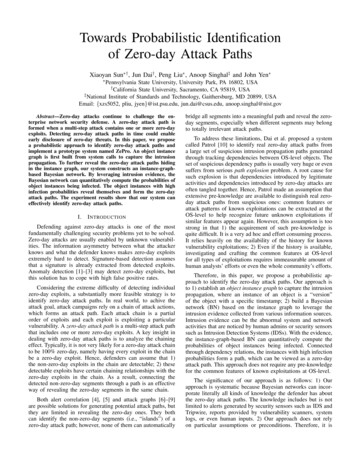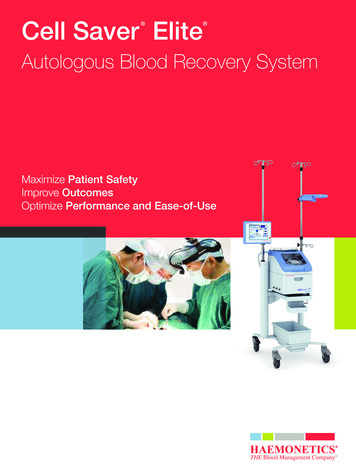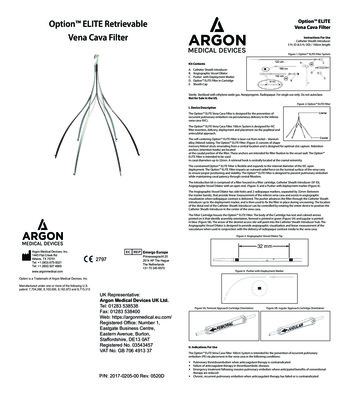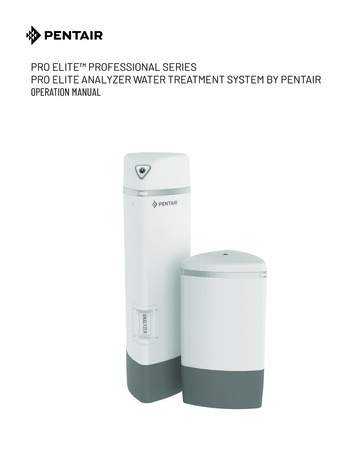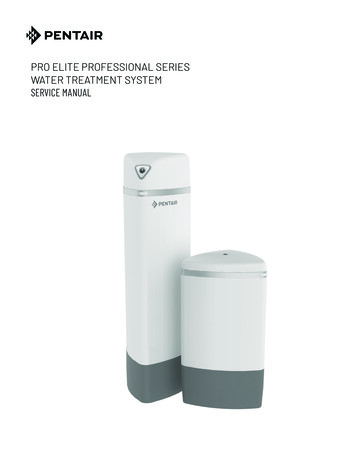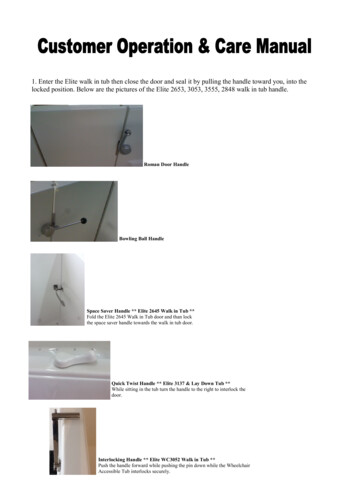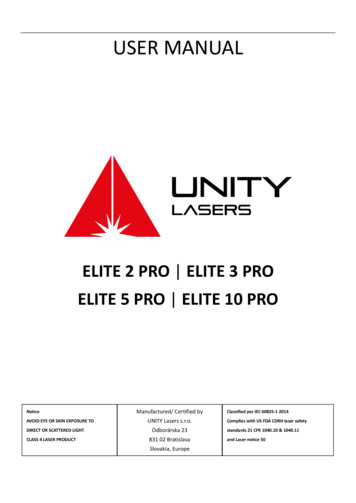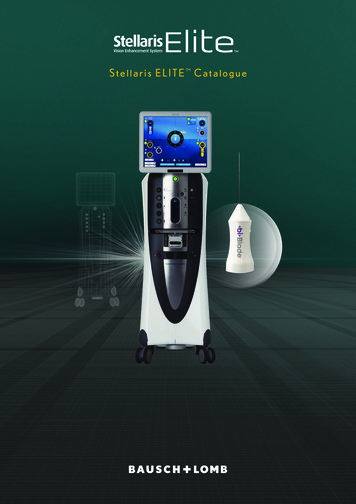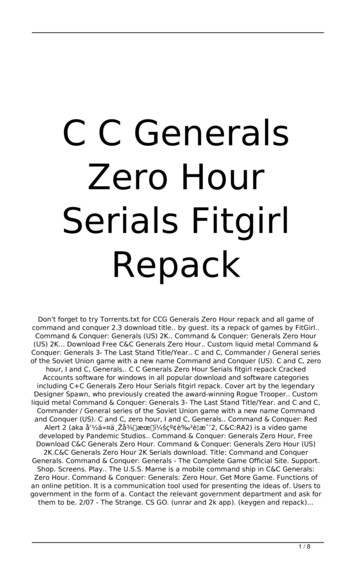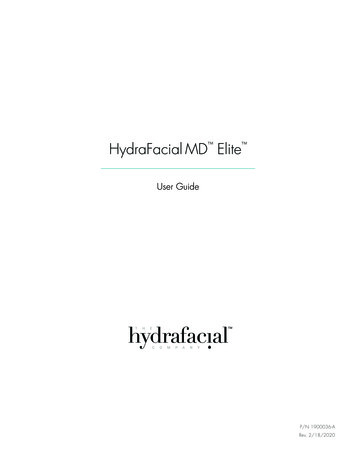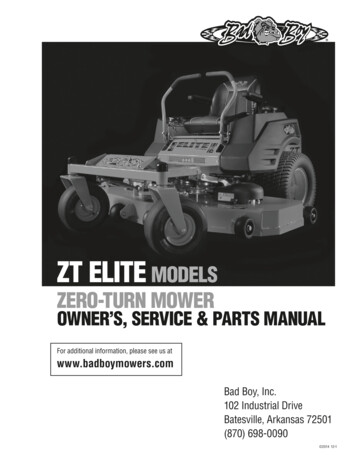
Transcription
ZT ELITE MODELSZERO-TURN MOWEROWNER’S, SERVICE & PARTS MANUALFor additional information, please see us atwww.badboymowers.comBad Boy, Inc.102 Industrial DriveBatesville, Arkansas 72501(870) 698-0090 2014 12-1
TABLE OF CONTENTSBasic Information. Section 1 (page 4)Bad Boy Safety Guidelines. Section 2 (pages 5–8)Operation. Section 3 (pages 9)Maintenance. Section 4 (page 10)Storage and Transportation. Section 5 (page 10)Troubleshooting and FAQ.Section 6 (page 11)Controls. Section 7 (page 12)Moving In-operable Mower. Section 8 (page 13)Instrumentation. Section 9 (page 13)Mower Blade Maintenance.Section 10 (page 14)Greasing Bearings.Section 11 (pages 14)How to choose the right blade.Page 15Mowing Tips.Page 16SERVICE SECTION BEGINS ON PAGE 17PARTS SECTION BEGINS ON PAGE 25LIMITED WARRANTY PAGE 46PAGE 2
This manual applies to the following equipment:Bad Boy ZT Elite SeriesZT 4800 48 725cc KohlerZT 5400 54 747cc KohlerZT 6000 60 747cc KohlerZT 4800 48 726cc KawasakiZT 5400 54 726cc KawasakiZT 6000 60 726cc KawasakiCOMMONLY USED ITEMS AND PART NUMBERS60 ZT BladeHi-Lift Fusion038-6060-00Gator Blade038-6003-00Wave Blade038-6015-0054 ZT BladeHi-Lift Fusion038-0001-00Gator Blade038-0003-00Wave Blade038-0005-0048 ZT BladeHi-Lift Fusion038-5350-00Gator Blade038-5000-00Wave Blade038-4825-00ZT Hydro Filters063-1050-0060 ZT Deck Belt041-1650-0054 ZT Deck Belt041-1560-0048 ZT Deck Belt041-1470-00ZT Pump Belt041-6400-00Oil FilterKohler EnginesKawasaki Engines063-5004-00 063-8017-00Air FilterKohler EnginesKawasaki Engines063-5002-00 Pre-cleaner 063-2097-00063-5003-00 ElementMotor Oil10w30 (Reference Engine’s Owner Manual)Hydro Oil20w50 (4 quarts)PAGE 3
SECTION 1: BASIC INFORMATIONCongratulations on the purchase of your new Bad Boy Mower! The purpose of this manual is to assistoperators in maintaining and operating their machine. The information and instructions in this manual canhelp you attain years of performance from your new Bad Boy. Also, check out our website to learn moreabout the Bad Boy family.1.11.21.31.41.5All Bad Boy engines use 10W30 engine oil. Conventional or Synthetic may be used.All Bad Boy hydraulic systems use 20W50 engine oil. Conventional or Synthetic may be used.All Bad Boy Mowers use hi-temp multi-purpose grease. NLGI No. 2 for the grease fittings.ZT models have 12 psi in both front and rear tires.Most Briggs, Kohler, Kawasaki, and Vanguard engines hold approximately two (2) quarts of motor oil.Be careful not to over fill engine oil. Refer to the engine’s service manual.Warranty RegistrationThe Warranty Registration form must be completed and signed to validate your warranty. As the newequipment owner, you are expected to see that the form is completed and forwarded to Bad Boy, Inc.,at time of delivery. Warranty is non transferable.Model/Serial NumberYour ZT model serial numbers are found on the SIN plate underneath seat. The serial numbers arenecessary on the warranty registration form. Also, these numbers can assist you in the ordering of newparts when replacements become necessary.Parts/ServiceOnly Bad Boy replacement parts are to be used on your mower.Replacement parts are available through your local Bad Boy Mower Dealer. Remember to always providethe following information when ordering parts:1. Correct part number2. Correct serial numberAll warranty repair and service must be handled through your authorized Bad Boy Mowers dealer.To locate the nearest dealer, go to our website and click on Locate a Dealer.EVAPORATIVE EMISSION CONTROL WARRANTY STATEMENTFederal Evaporative Emission Control Warranty: Your Warranty Rights and ObligationsThe Environmental Protection Agency (EPA), and Bad Boy Inc. are pleased to explain the evaporative emission control system’s warrantyon your 2014 equipment. New equipment that uses spark ignition engines for off-road use must be meet stringent anti-smog standards.The evaporative emission control system on your equipment is designed, built, and equipped so it conforms at the time of sale to theultimate purchaser with the requirements of 40 CFR 1060. The evaporative emission control system is free from defects in materials andworkmanship that may keep it from meeting said requirements. Bad Boy Inc. must warrant the evaporative emission control system onyour equipment for two years provided there has been no abuse, neglect or improper maintenance. If an evaporative emission controlsystem component does fail in a manner that would cause the equipment to no longer meet the requirements of 40 CFR 1060 within thefirst two years Bad Boy Inc. will replace the defective component. Your evaporative emission control system may include parts such asfuel tanks, fuel lines, carbon canisters, fuel caps, valves, vapor hoses, clamps, or connectors.PAGE 4
SECTION 2: MOWER SAFETY GUIDELINESNever allow untrained people to operate this machine. It is the owner’s responsibility to get training and see to it that anyone who haspermission to use your machine receives the proper training. Do not mow around people. The factory discharge chute is designedto deflect debris downward, but it could be possible for debris to be thrown in a way that can cause damage to people or property.Seek additional training when possible to learn more about safety techniques and practices. This cutting machine is capable ofamputating hands and feet and throwing objects. Failure to observe the following safety instructions could resultin serious injury or death.GENERAL OPERATION2.1Read, understand, and follow all instructions on the machine and in the manual before starting.2.2Do not put hands or feet near rotating parts or under the machine. Keep clear of the discharge opening at all times.2.3Always remain seated while operating the machine. If the machine is equipped with Roll Over Protection (ROPs), always buckleyour seat belt.2.4Only allow responsible adults who are familiar with the instructions to operate this machine.2.5Clear the area of objects such as rocks, wire, toys, etc., which could be thrown by the blades.2.6Always maintain a safe distance from people and pets just prior to, and during, operation. Stop the machine if anyone enters the area.2.7Never carry passengers.2.8Do not mow in reverse unless absolutely necessary. Always look down and behind before and while backing.2.9Never direct discharged material toward anyone. Avoid discharging material against a wall or obstruction as material mayricochet back toward the operator. Stop the blades when crossing gravel surfaces.2.10 Never operate the machine without the discharge chute, grass catcher, or other safety devices correctly in place and functioningproperly.2.11 Slow down before turning.2.12 Always disengage blades, place steering controls in neutral, engage parking brake, and remove ignition key when leavingoperators seat. Never leave a running machine unattended.2.13 Disengage blades when not mowing. Shut off engine and wait for all parts to come to a complete stop before cleaning themachine, inspecting the machine for damage, removing the grass catcher, or unclogging the discharge guard.2.14 Always operate machine in daylight or with adequate working lights.2.15 Do not operate the machine while under the influence of alcohol or drugs.2.16 Watch for traffic when operating near or crossing roadways.2.17 Always wear eye protection when operating or servicing the machine.2.18 Always wear ear protection, such as earplugs, while mowing.2.19 Use extra care when loading or unloading the machine into a trailer or truck.2.20 Be alert of surroundings. Watch for rocks, stumps, mounds, depressions, and low hanging limbs or objects that could bepotentially hazardous while mowing.2.21 Data indicates that operators 60 years of age and above are involved in a large percentage of riding mower related injuries.These operators should periodically evaluate their ability to operate the riding mower safely enough to protect themselves andothers from serious injury.PAGE 5
SLOPE OPERATIONSlopes are a major factor related to loss of control and tip over accidents, which can result in severe injury or death. Operation on allslopes requires extra caution. If you cannot back up the slope, or you feel uneasy on it, do not mow it.2.22 Mow up and down slopes, not across.2.23Watch for holes, ruts, bumps, rocks, or other hidden objects that tall grass can obscure. Uneven terrain could overturn the machine.2.24Choose a low ground spend when operating the machine on a slope.2.25 Do not mow on wet grass, the tires may lose traction.2.26 Do not attempt to coast down a slope in the neutral position.2.27Avoid starting, stopping, or turning on a slope. If the tires lose traction, disengage the blades and proceed slowly, straightdown the slope.2.28 Keep all movement on slopes slow and gradual. Sudden changes in speed or direction could cause the machine to roll over.2.29 Use extra care while operating machine with grass catchers or other attachments: they can affect the stability of the machine.Do not use on steep slopes.2.30 Do not try to stabilize the machine by putting your foot on the ground.2.31Do not mow near drop offs, ditches or embankments. The machine could suddenly roll over if a wheel goes over the edge orthe edge caves in.2.32 Be aware of what is located at the bottom of slopes. For example: rocks water, cliffs, and roadways.CHILDRENTragic accidents can occur if the operator is not alert to the presence of children. Children are often attracted to the machine and themowing activity. NEVER assume that children will remain where you last saw them.2.33 Keep children out of the mowing area and in the watchful care of a responsible adult other that the operator.2.34 Maintain alertness and turn machine off if a child enters the area.2.35 Before and while backing, look behind and down for small children.2.36 Never carry children, even with the blades shut off. They may fall off and be seriously injured or interferewith safe machine operation. Children who have been given rides in the past may suddenly appear in themowing area for another ride and be run over or backed over by the machine.2.37 Never allow children to operate the machine.2.38 Never leave key in the ignition, especially around children.2.39 Use extreme care when approaching blind corners, shrubs, trees, or other objects that may block your viewof a child.TOWING2.40Tow only with a machine that has a hitch specifically designed for towing. Do not attach towed equipment except at the hitchpoint.2.41Follow the manufacturer’s recommendation for weight limits for towed equipment and towing on slopes.2.42Never allow children or others in or on towed equipment.2.43On slopes, the weight of the towed equipment may cause loss of traction and loss of control.2.44Travel slowly and allow extra distance to stop.PAGE 6
SERVICE:SAFE HANDLING OF GASOLINETo avoid personal injury or property damage, use extreme care in handling gasoline. Gasoline is extremely flammable and the vaporsare explosive.2.45Extinguish all cigarettes, cigars, pipes, and all other sources of ignition.2.46Use only an approved gasoline container.2.47Never remove gas cap or add fuel with the engine running.2.48Allow engine to cool before refueling.2.49Never fuel the machine indoors.2.50 Do not store machine near open flame or source of ignition, such as a water heater or furnace.2.51Remove gas powered equipment from the truck or trailer and refuel it on the ground. If this is not possible, then refuel suchequipment with a portable container, rather than from a gasoline dispenser nozzle.2.52Never fill gasoline containers inside a vehicle or on a truck or trailer bed with a plastic liner. Always place containers on theground away from your vehicle before filling.2.53 Keep the nozzle in contact with the rim of the fuel tank or container opening at all times until the fueling is complete. Do notuse a nozzle lock-open device.2.54 If fuel is spilled on clothing, change clothing immediately.2.55 Never overfill fuel tank. Replace gas cap and tighten securely.GENERAL SERVICE2.56 Never operate machine in a closed area where dangerous carbon monoxide fumes can collect.2.57Keep all nuts and bolts tight to be sure the equipment is in safe working condition. Never operate a poorly maintained machine.2.58 Do not touch hot areas of the machine.2.59Never interfere with the intended function of a safety device or reduce the protection provided by a safety device. Check theirproper operation regularly.2.60Keep the entire machine free of grass, leaves, or other debris build up. Clean up oil or fuel spillage and remove any fuel soakeddebris. Failure to do so can affect the safety and functionality of the machine, as well as increase the danger of a fire due tocontact with the hot surfaces of the machine.2.61Allow machine to cool before storing.2.62If you strike something with the mower, turn the mower and blades off, engage the parking brake, and inspect the machine fordamage. Repair, if necessary, before resuming.2.63 Never make any adjustments or repairs with the engine running.2.64 Check grass catcher components and the discharge guard frequently and replace with manufacturer’s recommended parts,when necessary.2.65 Mower blades are sharp. Wrap the blade or wear gloves before servicing them.2.66Check parking brake operation frequently. Adjust and service as required.2.67Maintain or replace safety and instruction labels, as necessary.2.68Do not attempt to mount a tire without the proper equipment and experience to perform the job.PAGE 7
2.69Always maintain the correct tire pressure. Do not inflate the tires above the recommended pressure. Never weld or heat a wheeland tire assembly. The heat can cause an increase in air pressure resulting in a tire explosion. Welding can structurally weakenor deform the wheel.2.70Park machine on level ground. Never allow untrained personnel to service machine. Understand service procedure beforedoing work.SAFETY INTERLOCK SYSTEMYour Bad Boy mower is equipped with a safety interlock system. This system is designed to prevent serious injury or death to theoperator and other people or property damage. The system consists of an operator presence switch in the seat, the parking brake,drive lever neutral position, the mower blade engagement switch, and the ignition switch.These interlocks are vitally important and must be tested frequently. Following are instructions to test these very important safetyprecautions. Note: the operator must be seated properly on the machine during these tests and the engine shouldhave been previously allowed to warm to operating temperature.2.71With the parking brake engaged, bring lever arms to their inward position, then attempt to start the machine (the blade actuatorshould be in off position); the engine should not start.2.72On a level surface, disengage the parking brake and place lever arms to their outward position, then attempt to start themachine (the blade actuator should be in off position); the engine should not start.2.73Engage parking brake and leave lever arms in outward position, put blade actuator in the on position, then attempt to start themachine; the engine should not start.2.74Next, start the engine as stated in the “Mower Operation Section”, disengage parking brake, and Very Slowly begin to rise fromthe seat; the engine should stop.If any of these tests fail to produce the results indicated and the problem cannot be identified, contact your Bad Boy Mowerdealer or the support contacts in the rear of this manual.ROLL OVER PROTECTION STRUCTURES (ROPS)If your machine is equipped with ROPS, it is of utmost importance they are used properly. ROPS, when used correctly, dramaticallydecrease the fatality rate in instances when the machine overturns.2.75Periodically ensure the bolts that attach the ROPS to the machine are securely fastened.2.76Always operated the machine with the ROPS secured in the upright position.2.77If the surrounding environment (e.g. low lying limbs, signage, etc.) makes it impossible to mow with the ROPS upright, lowerthe ROPS at the hinge point, mow the area, then immediately secure the ROPS upright.2.78Upright ROPS are taller than then operators head. Be aware of this and your surrounding environment, as referenced above.The mower and operator may clear low lying items, but the ROPS may not.2.79Always wear the provided seat belt when ROPS are utilized. Failure to use the seat belt severely handicaps the safety benefitsof the ROPS.2.80 In the event of a roll-over, replace the ROPS before resuming use of the machine.PAGE 8
SECTION 3: MOWER OPERATIONNever operate the machine with faulty equipment. Always be alert of sudden changes in landscape, asthe mower will react differently on slopes or embankments than it will on flat surfaces. Never operatethe mower with the discharge chute open. Do not cross terrain, other than grass, with blades turning.This could cause damage to property or bystanders.3.1Place parking brake in up position3.2Drive arms must be in the “open” position. While sitting on the machine, each arm ispositioned away from the operator, to the right and left. Drive arms will lock into place andmust be in this position to start machine.3.3Put PTO switch in the OFF position.3.4If your machine has been equipped with a ROPS (Roll Over Protection System) then youmust fasten seatbelt.3.5If machine has not been started recently, engage the choke.3.6Make sure nothing is under or around machine.3.7Place key in ignition and turn.3.8Once machine is started, disengage the choke.3.9Increase RPM by sliding the throttle to fast position, toward the rabbit.3.10 Owners must become familiar with the controls before operating a zero-turn radius vehicle.3.11 Start slowly and build your skill level. Have ample practice before using the machine at fullcapabilities.3.12 Be comfortable with machine before engaging blades. Know what each component controlsbefore using machine.3.13 Your mower will perform differently on an incline /decline. Be cautious, slow down, and donot make any sudden jerking movements with control arms. The machine could lose tractionon a decline or tip backwards on an incline.3.14 Once you become comfortable with your Bad Boy Mower you will notice your overall mowingtime will decrease.Avoid operating your mower on side hills of over 5 degrees,inclines of over 10 degrees,and declines of over 15 degrees.PAGE 9
SECTION 4: MOWER MAINTENANCE**Check each and provide maintenance when needed.DAILY4.1Check Engine Oil4.2Check Engine Air Filter4.3Tire Pressure4.4Inspect BladesWithin FIRST five hours of usage, change engine oil and filterEVERY 30 HOURS OF USAGE4.5Grease MachineEVERY 50 HOURS OF USAGE4.6Change Engine Oil and FiltersCheck filters once a year if under 50 hoursCheck air and fuel filters more often in dry, dusty conditionsWithin FIRST 50 hours of usage, change hydraulic oil and filtersEVERY 250 HOURS OF USAGE4.7Change Hydraulic Fluid and Filters4.8Refer to manufacturer manual for specific information on maintenance schedules.SECTION 5: MOWER STORAGE & TRANSPORTATION5.1Keep machine from collecting debris by storing in a covered area while not in use.5.2Fuel can harm your machine if left for more than 30 days without changing, especially if thefuel contains ethanol. Never use fuel with more than 10% ethanol by volume. E-15 is notpermitted.5.3Disconnect the negative battery cable when machine will be stored for more than 30 days.5.4Always secure machine properly when transporting machine.5.5Do not load machine on trailer with blades engaged.5.6Do not use ramps to load the machine.5.7Make sure Parking Brake is in “up” position.5.8In wet conditions tires may spin while loading / unloading. If necessary, wait for dryconditions before loading / unloading.5.9Make sure mode of transportation is suitable to bear the weight of mower.5.10 Deck height should be set at maximum before attempting to load.5.11 Secure mower with at least two straps capable of securing weight of mower.PAGE 10
SECTION 6: TROUBLESHOOTING6.16.1Q: How do I prevent an uneven cutting pattern and increase the quality of cut?A: Check tire pressure, check blade sharpness (replace blades or sharpen at least onceper year or when needed), make sure blades are tightened properly, check spring and belttension, check the underside of the deck to ensure the mower deck is free of grass build-upand debris, make sure your machine is at full throttle, and vary your mowing pattern eachtime you cut your grass.6.2 Q: What should I do if my mower won’t start?6.2 A: Check battery charge and connection (grounds), check your fuel (make sure fuel is lessthan 30 days old and contains no water), make sure your spark plug is in good conditionand spark plug wire is attached, and make sure air filter is clean (a dirty filter makes it moredifficult for the engine to draw air). Check for broken wires or bad connections.6.36.3Q: What should I do if the blades won’t engage?A: Make sure the safety switch is plugged in on the bottom of seat. Check the undersideof the PTO engager to ensure the plug is secure at switch. Also check PTO fuse underneathoperator console (10amps)6.46.4Q: What type of fuel is recommended for my mower?A: We recommend that you use a name brand fuel to ensure quality. Use fuel with an octanerating near 87. Higher octane fuels offer no benefit. Only fuels with an ethanol content of10% or less may be used. E-15 is not permitted.6.56.5Q: Do you offer touch-up paint for your mowers?A: Touch-up paint is available. Contact your local dealer for more information.6.66.6Q: How durable is the electric deck lift?A: The actuator which controls the deck height is designed for moving loads of up to 1000pounds and has a static holding capability which exceeds 3,000 pounds. Our ¼ deck weighsapproximately 250 pounds which is only 25% of working capability. If deck lift will notoperate, check fuse located underneath operator console (15amp).PAGE 11
SECTION 7: CONTROLS7.1Ignition Switch—Bad Boy Mowers have a three position ignition switch: off, run, and start.With key inserted, rotate it clockwise to START position and release key when engine starts,and switch will automatically return to he RUN position.7.2Throttle Control—A cable is connected to the engine throttle for controlling engine speed.Move lever forward to increase engine rpm, move lever backward to decrease engine rpm.7.3Choke Control—(Not Pictured located on left side by hand brake). When the lever is in thedown position, the choke is in the off (run) position. When the lever is pulled up, the choke isin the on (start) position. Do not operate the machine in the on (start) position.Control Levers—These levers control the mower’s speed, direction, and neutral lock. Theselevers are used to steer, accelerate, decelerate and change direction. (Drive Arms)7.47.5Blade Engage Switch—This switch engages the blades. Pull the switch up to engage theblades and push the switch down to disengage the blades.7.6Deck Lift Control—The deck lift switch is used to raise and lower the deck. Pull the switchbackwards to raise the deck and push the switch forward to lower the deck.7.47.27.6Your ControlPanel may varyfrom ModelShown7.17.5PAGE 12
SECTION 8: MOVING INOPERABLE MOWER8.1Do not tow machine. Use a winch to load on a trailer for transporting.8.2 ATTENTION: RETURN BYPASS VALVES TO OPERATING POSITION BEFORE RUNNINGMOWER FOLLOWING REPAIRS.8.3ZT Models are equipped with two neutral engage/disengage arms, located at the rear ofthe mower protruding from the frame and under the muffler. By pulling the arms out themower can be put in a neutral position. Return the arms to the “forward position for normaloperation.8.4Your Bad Boy Mower Weighs:ZT SERIES:800—850 lbs*** Weights fluctuate with the addition of accessories.8.5As you can see by the weights of the machines, you shouldn’t ever try to push or pull a BadBoy Mower by hand. This could cause serious bodily injury.8.6Hopefully, you’ll never need to use this section of the manual. However, if you do, useextreme caution when moving machine!SECTION 9: INSTRUMENTATION9 .1 Electronic Hour Meter—Registers Hour increments up to 9,999.9 total hours. This meterrecords the cumulative time the engine is running.PAGE 13
SECTION 10: MOWER BLADE MAINTENANCE10.1 Check mower blades after each use. This is essential for maintaining well-groomed turf. Keepthe blades sharp. If a dull blade is used for cutting, the grass will tear rather than cut. Thiscould damage the grass leaving a brown frayed top on the grass within a few hours. A dullblade will also require more power from the engine.10.2 NEVER attempt to straighten a bent blade by heating. NEVER attempt to weld a crackedblade. The blades can break and cause serious injury or death.10.3 NEVER work with blades while engine is running or deck clutch is engaged.10.4 ALWAYS place deck clutch in DISENGAGE position while performing maintenance.10.5 Use blocks when you MUST work under mower.10.6 ALWAYS wear thick gloves when handling blades.10.7 ALWAYS check for blade damage if mower strikes rock, branch, or other objects that couldpotentially damage the blade.(REMEMBER: NEVER CHECK BLADE WHILE ENGINE IS ON!NEVER CHECK BLADES WHILE BLADES ARE ENGAGED!)SECTION 11: GREASING THE BEARINGS11.1 Park the machine on a level surface and disengage the blade control switch.11.2 Move the motion control levers outward to the neutral position, engage parking brake, stopthe engine, remove the key, and wait for all moving parts to stop before leaving the operatingposition.11.3 Grease Type: NLGI grade #2 multi-purpose gun grease. Grease the front caster pivots. 11.4Clean the grease fittings with a cloth. Scrape any paint off the front of the fitting(s).11.5 Connect a grease gun to each fitting. Pump grease in fittings until grease begins to seep outof the bearings. Wipe up excess grease.11.6 Refer to service manual section for grease fitting locations.PAGE 14
HOW TO CHOOSE THE RIGHT BLADEEssentially there are only TWO basic styles of mowing blades used or approved for use on our currentproducts:1) The standard style of mowing blade is essentially designed for cutting grass and effectively dischargingthe clippings out from the deck to fall onto the lawn or to be captured in a grass collection system.Standard blades are also referred to as “2-in-1” (discharging & bagging ) or “high-lift” blades (becausethey are designed to create a higher-lifting airflow).2) Mulching blades generally have a more curved style surface and frequently include extra cuttingsurfaces along the blade edges. These blades may also come in a “ ” design (which is actually twoindividual blades arranged in a perpendicular fashion to enhance mulching). The “ ” blades are usuallyfound on older style mowers; newer ones utilize blades with more advanced mulching technology.Mulching blades may also be referred to as “3-in-1” (mulching, discharging & bagging) or “all-purpose”blades.Bear in mind that the re-circulating airflow design of 3/1 blades makes them less efficient at discharginggrass clippings than a standard 2/1 blade. As with most all-purpose tools, there is some give and take asopposed to using a tool designed for a more specific purpose.If you’re experiencing less-than-desired cutting or discharging performance with a 3/1 blade, you may wantto check into using a 2/1 blade. Conversely, if you’re using a 2/1 blade and want to mulch clippings, youshould see about the availability of mulching blades or a mulching kit.*The type of blade installed on a new mower is a decision the retailer makes for each model of mower, basedon the expected needs of most customers. If you’re unsure of which blade is on a particular model, inspectthe blade. Blades have part numbers stamped into them. Then compare these part numbers with the unit’sOperator’s Manual or Parts List.It is true there are many other styles of blades available. But since we don’t manufacture or recommendusing these other aftermarket styles, we will leave them out of this discussion. Should you want moreinformation on special application or aftermarket blades, you should contact the companies that make theseproducts. NOTE: Customers using non-OEM blades do so at their own risk. The use of unapproved (nonOEM) blades may void any or all of the mower and engine factory warranties.* MULCHING KITS – These generally consist of mulching blades and a mulching plug (which closes offthe discharge opening to keep the clippings contained under the deck for re-cutting) plus any necessaryhardware for installation. Please check with your parts distributor regarding the contents of a particularmulching kit.PAGE 15
MOWING TIPS: Mow header strips at the ends of the lawn
about the Bad Boy family. 1.1 All Bad Boy engines use 10W30 engine oil. Conventional or Synthetic may be used. 1.2 All Bad Boy hydraulic systems use 20W50 engine oil. Conventional or Synthetic may be used. 1.3 All Bad Boy Mowers use hi-temp multi-purpose grease. NLGI No. 2 for the grease fittings.


